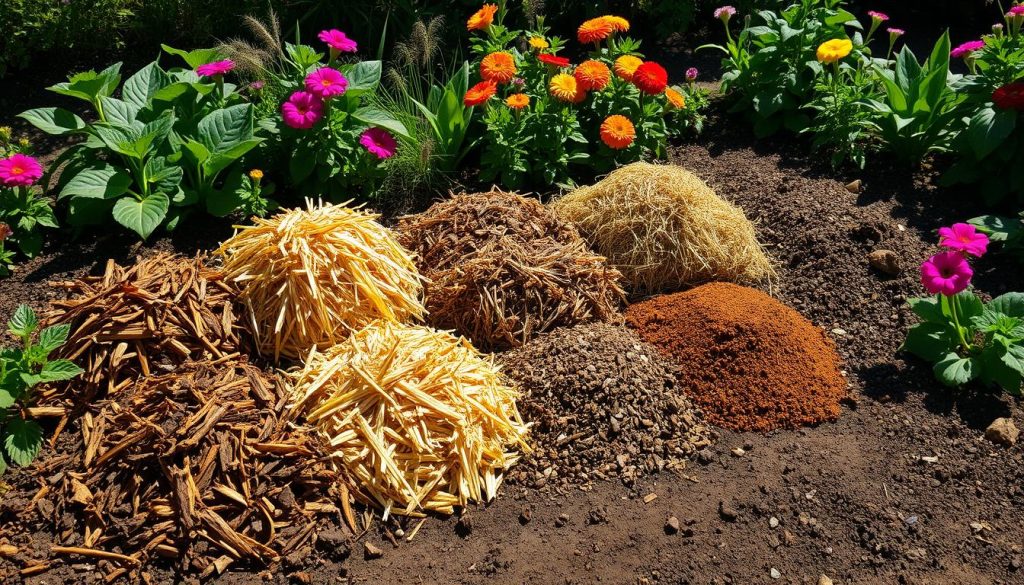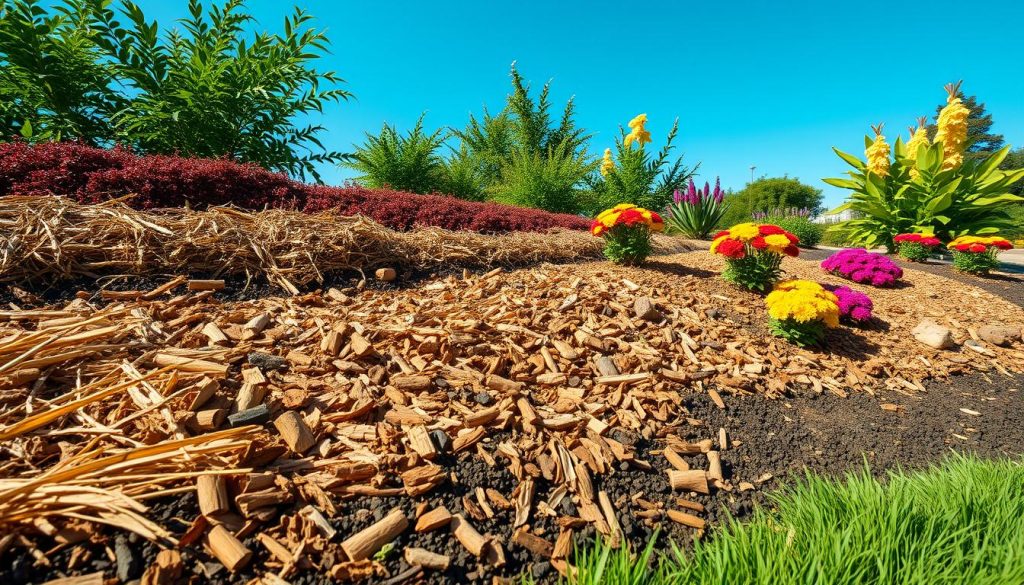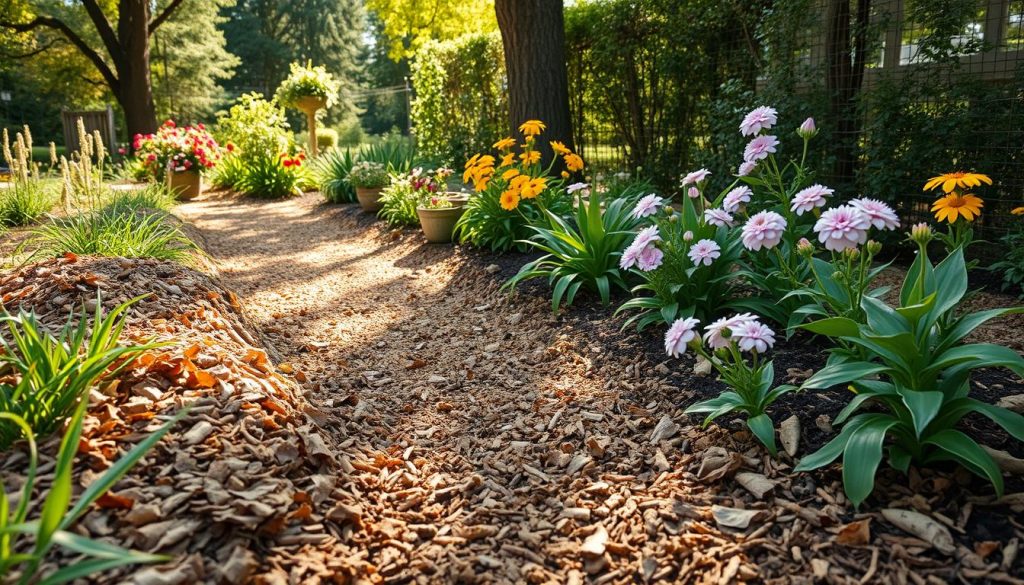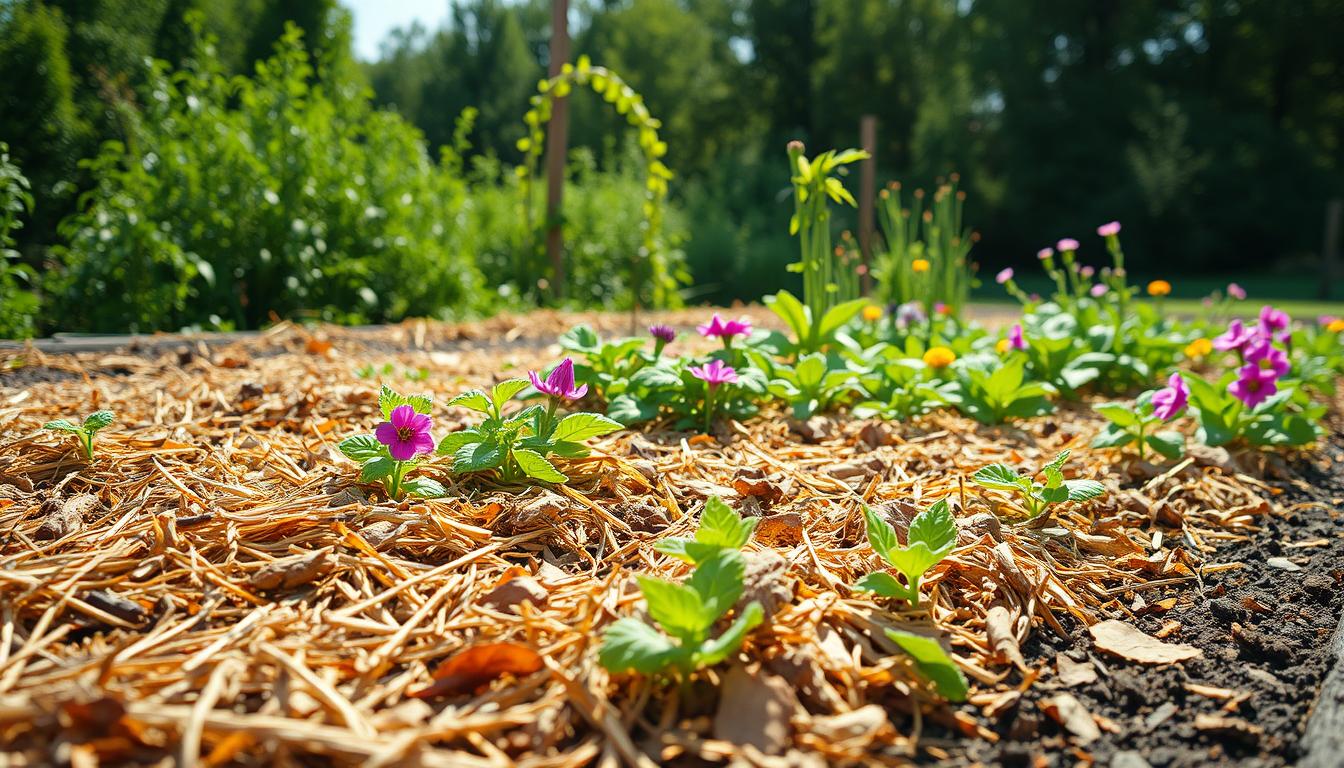I’m excited to share the benefits of organic mulching techniques. They can transform your garden. Organic mulching improves soil health, reduces weeds, and saves water. It makes your garden thrive and sustainable.
Choosing the right mulch is key. I’ll guide you through the process. This way, you can enjoy a lush and vibrant garden.
Organic mulching boosts your garden’s health in many ways. It improves soil structure and cuts down on fertilizers and pesticides. By picking the right mulch and using it correctly, you’ll have a beautiful, eco-friendly garden. Let’s explore how organic mulching can enhance your garden.
What is Organic Mulching?
Exploring organic gardening, I’ve learned the value of natural materials for soil health. Organic mulching uses natural materials to keep soil moist, fight weeds, and control temperature. It’s good for the environment and helps gardeners by improving soil and making nutrients more available.
Choosing natural mulches like wood chips, leaves, and grass clippings helps my garden grow. Organic mulching reduces soil erosion, improves soil quality, and boosts nutrient levels. It makes my garden more sustainable and productive.
Defining Organic Mulch
It’s key to pick organic mulch without chemicals or toxins. Materials like wood chips, leaves, and grass clippings are great. They’re easy to find and help soil health naturally.
Benefits of Using Organic Mulch
Using organic mulch offers many advantages:
- Improved soil structure and fertility
- Increased nutrient availability
- Reduced soil erosion
- Suppressed weed growth
- Regulated soil temperature
Choosing the Right Organic Mulch for My Garden
When I think about improving my garden, picking the right organic mulch is key. There are many options, and it’s important to pick one that fits my garden’s needs. I’ve found that using a 2-3 inch layer and keeping it away from plants is crucial.
It’s also important to choose eco-friendly mulching methods. I prefer using local materials and avoiding synthetic dyes to protect the environment. Some good choices include:
- Wood chips
- Bark
- Straw
I look at my garden’s climate, soil, and plants when picking mulch. This way, I get the best results. By following these tips and choosing eco-friendly options, my garden will flourish.

Choosing the right mulch and using it correctly brings many benefits. It improves soil health, reduces weeds, and keeps moisture in. With the right approach, my garden will be beautiful and easy to care for.
How to Apply Organic Mulch Effectively
To get the most out of organic mulch, applying it correctly is key. This means preparing the soil first and using the right amount. These steps help make your organic gardening and mulching more effective.
Preparing the soil is a big part of mulching. You need to remove weeds, loosen the soil, and add any needed amendments. This makes a healthy space for your plants to grow well. Important things to do include:
- Removing debris and weeds to prevent competition for nutrients
- Loosening the soil to improve drainage and aeration
- Adding organic matter like compost or manure to enrich the soil
Proper Thickness for Maximum Benefits
The right thickness of organic mulch depends on the type and climate. Usually, 2-3 inches is best. This thickness helps with weed control and keeps the soil moist without overheating. Using the correct amount ensures your mulch works well and your garden stays healthy.
By following these tips, you can make a garden that’s both beautiful and good for the environment. Always pick the right mulch for your needs and apply it correctly for the best results.
Best Practices for Organic Mulching Maintenance
To keep my garden thriving, I need to maintain the organic mulch regularly. Best organic mulches, like wood chips and straw, can last for several months. But, they need to be replenished from time to time. I check the mulch layer often to make sure it’s working well.
There are signs that tell me when my mulch needs attention. These include visible soil, weeds growing through, and a drop in soil moisture. When I see these signs, it’s time to add more mulch. Mulching helps control weeds by stopping them from growing and competing with plants.
When to Replenish Mulch
I add more mulch when it breaks down or gets too thin. This keeps it effective at holding moisture, stopping weeds, and controlling soil temperature. By doing this, my garden stays healthy and grows well.
Signs That My Mulch Needs Attention
Some common signs that my mulch needs attention include:
- Visible soil: If I can see the soil beneath the mulch, it’s time to add more.
- Weeds growing through the mulch: If weeds are growing through the mulch, it’s not doing its job.
- Decrease in soil moisture: If the soil is dry and cracked, the mulch may not be retaining enough moisture.

By following these best practices for organic mulching maintenance, I can keep my garden healthy, reduce weed growth, and conserve water. Using best organic mulches and mulching for weed control can make a big difference in my garden’s health and productivity.
How Organic Mulching Affects Soil Health
Exploring organic mulching has shown me its big impact on soil health. Using organic mulching techniques has greatly improved my soil’s structure and nutrient levels. The mulch breaks down, adding organic matter that helps the soil hold water and breathe better.
This supports the growth of beneficial microbes, which are key for plants to thrive. The benefits of organic mulching are many. It introduces good microbes to the soil, helping plants grow strong and healthy.
- Improved soil fertility and structure
- Increased crop yields
- Enhanced water retention and aeration
- Support for healthy microbial activity
As I keep learning about organic mulching, I’m eager to see more of its effects on soil health. With the right methods and materials, I’m sure I can make my garden a success. It will not only give me fresh food but also help the local environment.
Using Organic Mulch for Weed Control
I’ve found that organic mulching is great for controlling weeds naturally. Using natural mulches like wood chips or straw blocks weeds from growing. This method cuts down on the need for harmful chemicals and is better for the environment.
Organic mulch is effective because it blocks light and stops seeds from germinating. This makes it perfect for weed control. I mix mulch with other methods like hand-weeding and using barriers for a complete garden care plan.
How Mulch Suppresses Weeds Naturally
Organic mulch suppresses weeds in several ways:
- Blocking light: Mulch stops light from reaching the soil, making it hard for weeds to grow.
- Preventing seed germination: Mulch acts as a barrier, stopping seeds from sprouting and reducing weeds.
- Retaining moisture: Mulch keeps soil moist, making it harder for weeds to thrive.

Combining Mulch with Other Weed Management Techniques
To get the most out of organic mulch, I use it with other weed control methods. These include:
- Hand-weeding: Regularly pulling weeds to stop them from spreading.
- Using weed barriers: Installing barriers like landscape fabric to keep weeds out.
By using environmentally friendly mulching and combining it with other methods, I create a sustainable garden. This garden grows well without needing harmful chemicals.
Organic Mulching Techniques for Different Plants
Exploring organic gardening, I found that plants need different mulching. Tailoring mulching to each plant’s needs is key. This approach helps reduce waste and supports healthy growth.
Perennials like shrubs and trees need more mulch to keep moisture in and weeds out. Annuals, such as flowers and veggies, get by with less to avoid too much heat and water. Knowing these differences helps gardeners use compost and manure better for veggies and fruits.
Perennials vs. Annuals: Mulching Considerations
- Perennials: thicker mulch layer (2-3 inches) to retain moisture and suppress weeds
- Annuals: thinner mulch layer (1-2 inches) to prevent overheating and waterlogging
Tailoring Mulch to Vegetables and Fruits
For veggies and fruits, the right mulch balances moisture and air. Using straw or grass clippings helps control soil temperature and fights disease. This way, gardeners can grow more while being kind to the planet.
The Environmental Benefits of Organic Mulching
Usingorganic mulchingin my garden makes it look better and helps the environment. It stops soil from washing away, keeping waterways clean. It also saves water by keeping the soil moist, which is good for the planet.
Another great thing aboutorganic mulchingis that it attracts good bugs like bees and butterflies. Mulches like wood chips and straw make a home for these important pollinators. This makes my garden healthier and more sustainable.
Exploringmulching for weed controland other organic gardening is exciting. It shows how these practices can help the environment. By using these methods, I’m not just making my garden look nice. I’m also helping to protect our natural resources.
section>

